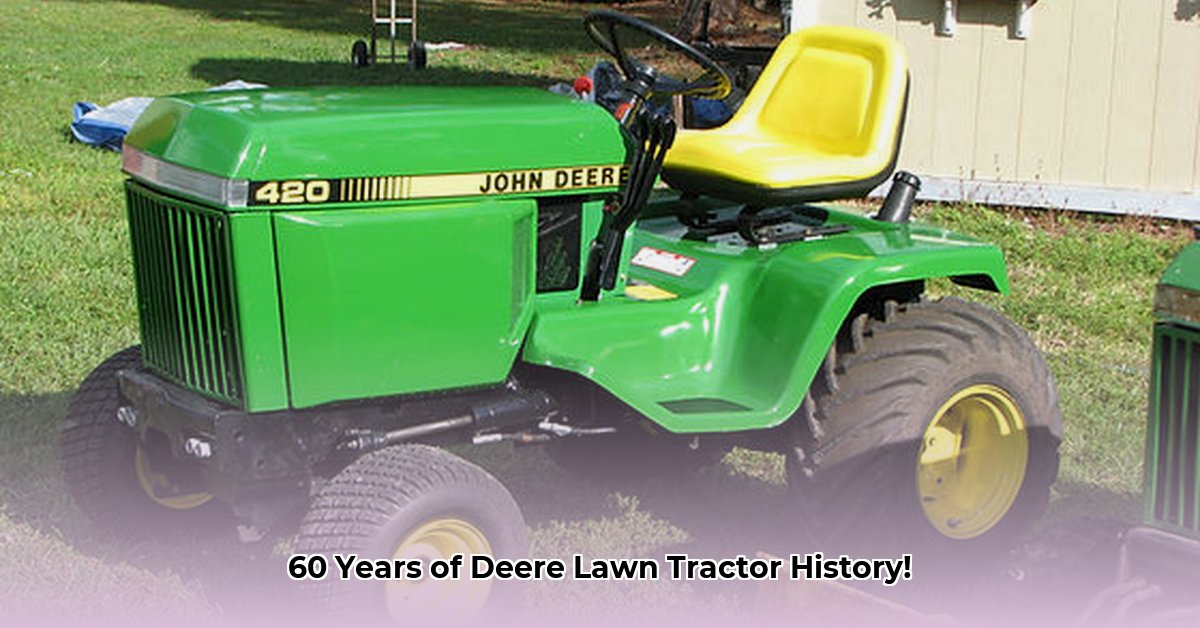
Old John Deere Lawn Tractors: A Legacy of Innovation
Forget the back-breaking labor of push mowers! The introduction of the John Deere Model 110 in 1963 revolutionized lawn care, marking a pivotal shift towards mechanized mowing. This article explores the fascinating evolution of John Deere lawn tractors, their technological advancements, environmental impact and lasting influence on individuals and industries. For a detailed comparison of models, check out this helpful chart.
A Green Revolution on Your Lawn: The Rise of the Riding Mower
The Model 110's arrival in 1963 transformed lawn maintenance. Previously, tending large lawns was physically demanding; the Model 110 provided a comfortable and efficient alternative. This convenience triggered a widespread adoption of riding mowers, fundamentally changing lawn care practices. Did you know that before the Model 110, many homeowners considered lawn care a grueling weekend chore?
Technological Leaps and Bounds: More Than Just a Mower
Early John Deere lawn tractors, while simple by today's standards, were revolutionary for their time. The Model 110, with its comparatively powerful engine, set a new benchmark. Subsequent models showcased even greater power and refined features. A particularly significant innovation was the introduction of hydrostatic drives (automatic transmissions allowing for effortless speed and direction control). This advancement significantly improved the user experience. Moreover, John Deere expanded the functionality beyond mowing with a variety of attachments such as tillers, snow blowers, and carts.
What features were most impactful? The steadily increasing engine power stands out. The implementation of user-friendly hydrostatic drives, replacing cumbersome gear-shift systems, significantly enhanced ease of use. Finally, the diverse range of attachments broadened the machines' utility, transforming lawn care from a strenuous chore to a more efficient and enjoyable task.
The Environmental Footprint: A Greener Future?
Early models, relying heavily on gasoline, raised concerns about their environmental impact. High fuel consumption and air pollution became significant issues. However, John Deere and others have addressed these concerns. Improvements in engine efficiency have reduced fuel consumption and emissions. Research into alternative fuels like biofuels is ongoing, representing a step towards sustainability. Furthermore, increased emphasis on responsible recycling programs and better end-of-life management of these machines is crucial. The transition to electric models promises zero-emission operation.
Who Benefits? The Impact of Mechanized Mowing
John Deere lawn tractors have had widespread effects. Farmers gained enhanced efficiency in managing large properties. Landscapers found them essential for meeting client needs. Homeowners experienced unprecedented convenience. While John Deere profited substantially from this new market, the mechanization also displaced some manual labor jobs. Environmental agencies now actively work to assess and mitigate the environmental impact of these machines, highlighting the complex interplay of social, economic, and ecological factors.
A Sustainable Future: Looking Ahead
John Deere lawn tractors represent a remarkable story of innovation and progress. They transformed lawn care, evolving from basic machines to sophisticated tools. However, future lawn care must prioritize sustainability. This necessitates a shift towards zero-emission models, improved recycling practices, and more eco-friendly manufacturing processes. Collaboration between manufacturers, policymakers, and consumers is integral to ensuring environmentally responsible lawn care practices.
A Closer Look at Some Model Innovations:
| Model | Approximate Year | Notable Features |
|---|---|---|
| Model 110 | 1963 | Introduced the riding lawn tractor concept |
| Model 112 | 1960s | Likely featured engine improvements |
| Later Models | 1970s-1990s | Hydrostatic drive became more common, expanded attachments became available |
This table only highlights some models; further research will reveal more details about John Deere's contributions to lawn care history.
How to Make John Deere Lawn Mower Maintenance Sustainable
Key Takeaways:
- Regular maintenance significantly extends the lifespan of your John Deere lawn mower, saving you money and resources.
- Proper maintenance minimizes environmental impact via optimized fuel efficiency and reduced waste.
- Sustainable practices, such as using biofuels and recycling parts, further reduce environmental impact.
- A well-maintained mower provides a superior cut, improving lawn health and aesthetics.